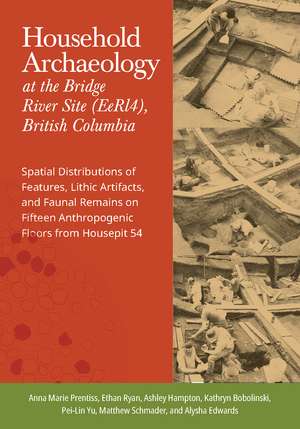Household Archaeology at the Bridge River Site (EeRl4), British Columbia: Spatial Distributions of Features, Lithic Artifacts, and Faunal Remains on Fifteen Anthropogenic Floors from Housepit 54
Autor Anna Marie Prentiss, Ethan Ryan, Ashley Hampton, Kathryn Bobolinski, Pei-Lin Yu, Matthew Schmader, Alysha Edwardsen Limba Engleză Hardback – 29 sep 2022
The authors take a methodological approach that integrates the study of household spatial organization with consideration of archaeological formation processes. Repeating the same set of analyses for each floor, they examine stability from standpoints of occupation and abandonment cycles, structure and organization of activity areas, and variation in positioning of wealth-related items. This volume is an outstanding example of research undertaken through a collaborative partnership between scholars from the University of Montana and the community of the St’át’imc Nation.
Preț: 514.41 lei
Preț vechi: 605.18 lei
-15% Nou
Puncte Express: 772
Preț estimativ în valută:
98.43€ • 102.57$ • 81.50£
98.43€ • 102.57$ • 81.50£
Carte indisponibilă temporar
Doresc să fiu notificat când acest titlu va fi disponibil:
Se trimite...
Preluare comenzi: 021 569.72.76
Specificații
ISBN-13: 9781647690519
ISBN-10: 164769051X
Pagini: 240
Ilustrații: 97 illustrations, 1 map
Dimensiuni: 178 x 254 x 20 mm
Greutate: 0.61 kg
Editura: University of Utah Press
Colecția University of Utah Press
ISBN-10: 164769051X
Pagini: 240
Ilustrații: 97 illustrations, 1 map
Dimensiuni: 178 x 254 x 20 mm
Greutate: 0.61 kg
Editura: University of Utah Press
Colecția University of Utah Press
Recenzii
“A significant contribution to analytical methods in household archaeology. There are relatively few studies that can examine changes in the use of a single house structure over this much time. The careful hypothesis-testing using traditional knowledge as a frame of reference makes this study a model for others in this field.”
—Amber Johnson, Truman State University
“The longevity and complexity of pithouse occupations at Bridge River—and potentially at other sites nearby—are profoundly interesting findings, and the balance evident in the Fraser River Valley between tendencies towards hierarchy/inequality and egalitarianism/communality is fascinating. These topics and sophisticated insights from this book are of great interest to global conversations in archaeology.”
—Christopher B. Rodning, Tulane University
—Amber Johnson, Truman State University
“The longevity and complexity of pithouse occupations at Bridge River—and potentially at other sites nearby—are profoundly interesting findings, and the balance evident in the Fraser River Valley between tendencies towards hierarchy/inequality and egalitarianism/communality is fascinating. These topics and sophisticated insights from this book are of great interest to global conversations in archaeology.”
—Christopher B. Rodning, Tulane University
Notă biografică
Anna Marie Prentiss is Regents Professor of Anthropology at the University of Montana. She is editor of The Last House at Bridge River and author of Field Seasons, and People of the Middle Fraser Canyon, and editor of Handbook of Evolutionary Research in Archaeology.
Cuprins
List of Figures
List of Tables
Acknowledgments
1. Housepit Floor Formation Processes, Activity Areas, and Sociality: The Record from Housepit 54
2. The Final Floor: Stratum IIa
3. Final Wealth-Based Distinctions: Stratum IIb
4. Persistence during the Second Demographic Trough: Stratum IIc
5. Social Complexity Continues: Stratum IId
6. The Demographic Peak and the Emergence of Social Complexity: Stratum IIe
7. A Crowded House: Stratum IIf
8. The Collectivist House Strategy: Stratum IIg
9. The Final Communalist House: Stratum IIh
10. Survival During the First Demographic Low: Stratum IIi
11. Short Winter Occupation Cycles: Stratum IIj
12. Large Scale Storage and Hints of a Shorter Winter Cycle: Stratum IIk
13. The First Rectangular House: Stratum IIl
14. The Last Small House: Stratum IIm
15. The Second Small House: Stratum IIn
16. Housepit 54 Begins: Stratum IIo
17. Conclusions
References
Index
Descriere
Combines academic and Indigenous insights to interpret the archaeological record of a long-lived household in British Columbia
